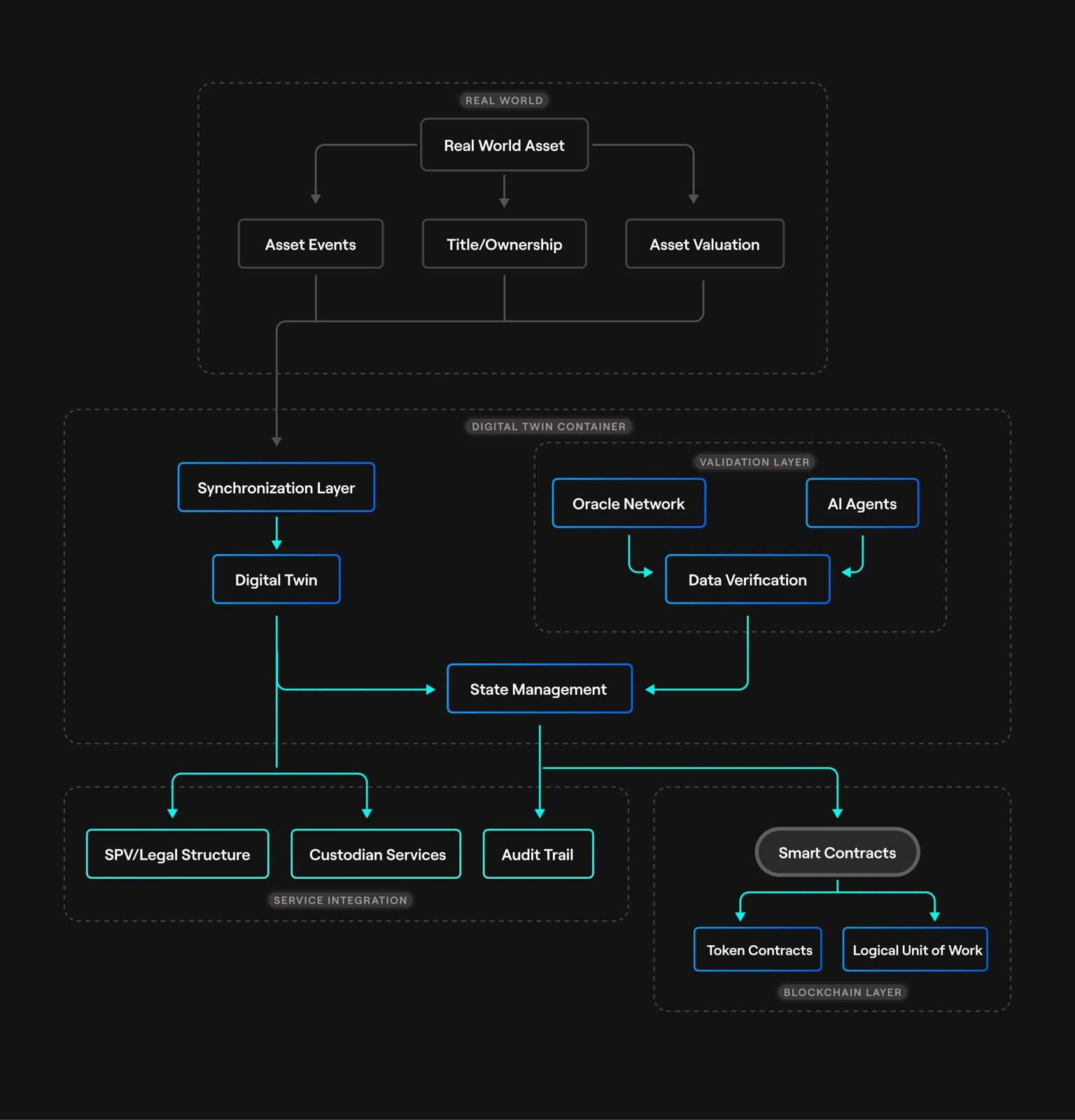订阅 wiki
Share wiki
Bookmark
Novastro
Novastro
Novastro 是一个金融技术平台和模块化基础设施层,专为现实世界资产(RWA)的代币化而设计。该平台通过利用人工智能、模块化账本和以合规为中心的框架,将物理和传统资产转化为流动性强的跨链数字工具。 [1] [2]

概述
Novastro 是一个基于区块链的平台,专注于现实世界资产 (RWA)的代币化。它使用一个模块化的账本系统,以 以太坊 为基础来确保安全性,同时将交易和互操作性扩展到 Arbitrum、Sui 和 Solana 等网络。该平台支持跨链发行和管理代币化资产,如房地产、金属、基础设施和知识产权,旨在提高流动性并减少与传统市场相比的障碍。
通过 智能合约 和基于 SPV 的框架,Novastro 支持自动化合规、资产生命周期管理和结算,从而最大限度地减少对中介机构的依赖。其架构为企业提供开发者工具和集成选项,以便跨链代币化和交易资产,其中 $XNL 代币为链上收益机制和资产策略提供动力。 [3] [9]
产品
数字孪生容器 (DTC)
Novastro 的数字孪生容器 (DTC) 是 智能合约,代表链上的 现实世界资产,并由法律结构支持,以确保可执行的所有权。它们支持代币发行、部分所有权、合规性执行、股息分配和跨链集成,使其成为发行人、投资者和开发人员的功能性工具。每个 DTC 都与一个特殊目的实体 (SPV) 相关联,该实体持有基础资产并将 KYC 和管辖限制等合规机制直接嵌入到合约中。
DTC 架构通过多层连接物理和数字领域。现实世界层管理资产、所有权、估值和事件跟踪,而核心组件维护同步、数字副本和状态管理。验证层使用 AI 代理 和 预言机 来确保数据准确性,而 区块链 层则执行合规性和代币化。SPV、托管人和审计跟踪等服务集成提供监管和法律支持。
通过结合同步、法律可执行性、合规性自动化和互操作性,DTC 将 现实世界资产 转化为可编程和可组合的金融工具。它们支持实时资产跟踪、跨链流动性以及与 DeFi 应用程序的集成,同时保持透明度、安全性和监管一致性。 [4]

链路由器
Novastro的链路由器是一个跨链桥和消息传递中心,使数字孪生容器(DTC)代币能够在以太坊、Arbitrum、Solana、Sui和其他生态系统之间无缝移动。它结合了链上合约、链下中继器和API来管理代币转移,执行特定于链的逻辑,并抽象出gas费用。该系统允许以ETH、$XNL或其他支持的资产支付费用,从而简化了多链可用性,而无需用户在每个网络上维护原生代币。
该过程依赖于安全的第三方桥,如Wormhole、LayerZero和Axelar。代币锁定在以太坊上,而等效的包装代币在目标链上铸造,从而确保供应一致性。当转回时,包装代币被销毁,原始资产被释放。这种方法保持了资产的可追溯性,同时将核心互操作性安全性外包给经过审计的桥提供商。
通过集成第三方基础设施而不是构建自己的基础设施,Novastro降低了风险并加速了跨链部署。链路由器是Novastro多链战略的支柱,确保代币化的现实世界资产可以在多个DeFi生态系统中流通,而不会影响合规性、功能或用户体验。 [5]
RWA Marketplace
RWA Marketplace是Novastro的代币化现实世界资产交易平台,旨在汇集流动性、跨链执行和易于访问的用户界面。它支持两种主要的交易模式:基于AMM的以太坊和EVM兼容链上的快速、低成本交易,以及通过与高性能DEX(如Injective和Serum)集成实现的订单簿交易,供喜欢传统市价单或限价单的用户使用。这种双重方法允许零售用户和机构以适合其需求的格式访问碎片化资产。
该市场将代币化资产聚合到一个门户中,用户可以在其中浏览包含资产类型、估值、收益率、所有权结构和合规状态等详细信息的列表。跨链执行通过Novastro的消息传递中心处理,使资产可以在各个生态系统中进行交易,而无需用户管理技术复杂性。
该平台的界面优先考虑非加密货币用户的可访问性,提供包含投资组合摘要、价格图表和现实世界财务指标的仪表板。入职灵活,支持钱包连接和基于电子邮件的帐户,而响应式设计确保了桌面和移动设备上的可用性。这种设置使RWA Marketplace成为发现和交易传统金融参与者熟悉的代币化资产的综合场所。 [7]
收益耕作与结构化产品
Novastro 的 收益耕作 与结构化产品模块将代币化的 现实世界资产 转化为与 DeFi 集成的收益生成工具。用户可以在精选的池中质押 RWA 代币,赚取 $XNL 或合作伙伴代币的激励,并参与治理以获得额外奖励。这些功能支持生态系统流动性,同时为被动和主动投资者创造机会。
该模块还引入了为风险管理敞口量身定制的结构化产品。多元化的金库将 稳定币 存款分配到 RWA 代币篮子中,自动化池根据 预言机 和 DTC 数据进行重新平衡,跨链聚合器将资金导向整个生态系统中最强大的机会。每种产品都通过 DTC 在法律上与基础资产相关联,并通过 预言机 驱动的绩效指标进行增强,从而确保合规性、透明度和自适应风险管理。 [8]
服务提供商层
Novastro的服务提供商集成层将代币化的现实世界资产连接到它们所代表的法律、金融和运营系统。通过标准化的API、预言机桥和智能合约钩子连接托管人、审计师、评估师、KYC提供商、保险公司和律师事务所,确保每个数字孪生容器(DTC)都反映经过验证的链下数据。托管人可以更新所有权证明,审计师和评估师可以提供财务报告和估值,KYC提供商可以执行参与者资格,保险公司可以将承保条款直接编码到代币逻辑中——在资产的整个生命周期中保持合规性和透明度。
对于发行人来说,该层提供了一个即插即用的市场,可以在代币创建时嵌入受信任的服务提供商,而开发人员可以获得一个统一的API,用于查询实时服务支持的数据并将其集成到仪表板或DeFi应用程序中。这创造了一种网络效应,每个新的提供商都加强了生态系统的合规性和投资者信心,同时也受益于Novastro平台上的广泛曝光。随着时间的推移,集成层演变为一种共享的信任基础设施,随着现实世界资产的代币化而扩展。 [6]
架构
代币化层
Novastro 的代币化层通过结合特殊目的实体 (SPV)、数字孪生容器 (DTC) 和智能合约的模块化系统,将现实世界资产转换为合规的数字代币。SPV 持有法定所有权并管理链下资产,而 DTC 在链上反映其财务和法律状态,嵌入估值、合规性和收入数据。这种设计支持部分所有权、自动化合规以及与 DeFi 的集成,使代币能够发行、交易并用于产生具有可执行法律支持的收益。
该过程始于资产上线,审计师和法律合作伙伴执行验证,然后将 SPV 链接到 DTC。然后将资产细分为代表基础 SPV 索赔的代币,并通过白名单、KYC/AML 和管辖限制来执行合规性。智能合约模块管理估值更新、收入分配、访问控制和审计跟踪,确保透明度和安全性。通过减少中介机构并从一开始就嵌入合规性,Novastro 的框架提供了可扩展的代币化基础设施,可以适应多种资产类别,同时保持监管一致性和运营效率。 [10]
交易层
Novastro 的交易层提供了一个多链基础设施,将代币化的现实世界资产转化为可交易、高流动性的工具,同时解决碎片化、高费用和监管复杂性问题。以太坊 Layer 2,例如 Arbitrum 和 Optimism,托管镜像 DTC 逻辑的交易合约,使桥接的 RWA 能够参与 DEX 流动性池、借贷市场和许可的金库。Solana 支持代币化股票或短期债务等资产的高速、低延迟交易,以太坊 上的代币通过 Wormhole 桥接,并在像 Serum 这样的订单簿 DEX 上列出。Sui 利用基于 Move 的 智能合约 进行结构化资产管理和动态所有权,促进 收益耕作 和基于 tranche 的债务策略的实时执行。
该层还集成了 Cosmos 链,包括 Injective 和 Osmosis,用于 IBC 兼容的部署,支持订单簿和 AMM 交易模型。跨链消息传递中心协调所有链之间的互操作性,使用 Wormhole、LayerZero 和 Axelar 来管理桥接、消息传递和自动铸造/销毁或锁定/解锁流程。该系统确保统一的资产 ID 跟踪,为用户抽象 gas 支付,并提供回调以通知 智能合约 跨链代币移动,从而实现跨多个生态系统的无缝、合规和可扩展的 RWA 交易。[11]
XNL
$XNL 是 Novastro 的原生 实用代币,是整个生态系统中交易、治理和参与的基础。它充当 gas 代币,用于支付 交易费用,支持质押以保护网络安全,并通过其作为基础交易对的使用来实现流动性提供。持有者还获得治理权,允许他们影响升级、参数更改和生态系统资金,从而将社区参与直接与平台开发联系起来。[12]
除了在交易和治理中的作用外,$XNL 还支持 Novastro 内的 现实世界资产 管理。它用于支付协议费用,支持代币化 RWA 市场的流动性,并运营数字孪生容器,为代币化资产提供合规性和生命周期管理。这种多层设计将 $XNL 定位为 Novastro 基础设施的核心要素,确保可扩展性、透明度和社区驱动的增长。 [12]
合作伙伴
- ICB Labs
- Bhopal DAO
- Orochi Network
- Flexafina
- Kaito
- MAIV
- Stability WorldAI
- WIZZ
- Terminus Network
- DualMint
- Lumishare
- openledger
- nudge
- gains associates
- Demonopol
- Paal mind
- Collably
- Amano invest
- Allora labs
- plena
- tiamonds
- Atomic wallet
- Prop chain
- Pixlrwa
- rwa inc
资产链接
- Welf finance
- Brillion
- TVVIN
- Airas
发现错误了吗?
